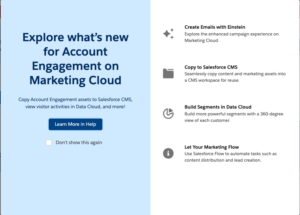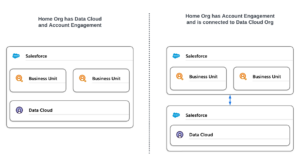Firstly, what is ‘lead source’?
Let’s start by defining what a ‘lead source’ actually is and why we use it.
When a prospect in Account Engagement syncs with Salesforce, Account Engagement creates a Lead. As marketers, we want to know where this lead has come from and which activity brought this lead to the attention of our sales team. Whether that’s through a search engine to the company website or whether it’s the effort of the marketing team, knowing where they have come from will only enrich the data and measure the effectiveness of lead generation campaigns.
Essentially it’s the first tracked interaction with the lead that populates the source field. This data comes from the referring URL, this is the URL (page) that the visitor was on before they visited a page with Account Engagement Tracking on.
So, why do we track this information?
When examining leads, whether these are Marketing or Sales, populating the lead source field is always beneficial. Not only does this metric allow marketers to see which channels are bringing the most leads in, but this information is visible to the sales team too. When following up with leads, understanding their journey will give the sales team more information on the content they have previously interacted with. This allows the team to understand the journey taken to becoming a lead, allowing for a more targeted message at the first point of contact.
Knowing where your leads are coming from allows you to monitor, track and report on the successes of your campaigns. By successes, we are talking about which channels are bringing in the most leads and which channels bring in the strongest leads. Knowing this will allow you to optimise your marketing strategy and utilise your marketing channels. For a marketer running lead generation campaigns, the number of leads should be a key metric during reporting, however quality over quantity is an important factor. Being able to identify the channels used to bring in leads that convert will improve your ROI.
This all sounds good, but how does it work?
Lead Source is a default Salesforce picklist field with pre-populated values. This is mapped to the Source field in Account Engagement, which can be found on the prospect record. The nature of picklist fields limits the display to only one value for Lead Source, which can limit your reporting. But that’s a whole different blog topic – keep your eyes peeled for that one 👀

The Lead Source predefined values can be updated in Salesforce – here’s a link to the Salesforce help guide: Add or create a new Lead source. However, there are some scenarios where Account Engagement populates this field automatically for you, there’s a really handy help guide from Salesforce that you can access here: How a Prospect’s Source Field Is Populated to help understand when this occurs.
Where are the fields located?
When it comes to using the Source field in Account Engagement, there are two visible on the prospect record if you have the Google Analytics Connector enabled, which can become a little confusing.

The Additional Fields Section is located on the left-hand side of the screenshot above highlighted using the yellow boxes, these are the default Account Engagement fields.
The fields under the Google Analytics header, featured on the right-hand side of the above screenshot in the red boxes, only appear when you have the connector enabled. If you’re expecting to see them and there’s nothing there or have any questions please do get in touch with a member of the team.
Google Analytics UTM parameters automatically update these fields; however, if there are any discrepancies or missing information, you can manually update the fields. Adding UTM parameter information to your links will allow you to see how many prospects your marketing activities are bringing in.
You can use these fields to report how many prospects have each field value. The values themselves can be as granular as you’d like. For example, you can use Social Media or Facebook/Twitter/LinkedIn. Reporting on how your marketing efforts are contributing to your pool of prospects is valuable for ROI.
Want to know more about leads and their best practices? Read our Get More Out of Your Leads with These Best Practices blog post here.
This Pardot article written by:
Nebula Consulting
Get the most out of marketing automation with Pardot. Attract and nurture leads with personalized, targeted journeys and adapt quickly with intelligent campaign performance insights. Start with the right building blocks to ensure you get the most out of your marketing automation strategy.
Original Pardot Article: https://nebulaconsulting.co.uk/insights/lead-source-tracking-in-account-engagement-pardot/
Find more great Pardot articles at https://nebulaconsulting.co.uk/insights/
Pardot Experts Blog
We have categorized all the different Pardot articles by topics.
Pardot Topic Categories
- Account Based Marketing (ABM) (7)
- Business Units (14)
- ChatGPT / AI (3)
- Completion Actions (5)
- Connectors (10)
- Custom Redirects (4)
- Data Cloud (3)
- Demand Generation (8)
- Dynamic Content (7)
- Einstein Features (11)
- Email Delivery (17)
- Email Open Rates (3)
- Pardot A/B Testing (2)
- Email Mailability (16)
- Do Not Email (1)
- Double Opt-in (2)
- Opt Out / Unsubscribe (14)
- Email Preferences Page (6)
- Engagement Studio (16)
- Industries (1)
- Non Profit (1)
- Landing Pages (9)
- Lead Generation (1)
- Lead Management (13)
- Lead Routing (3)
- Lead Scoring (16)
- Leads (3)
- Marketing Analytics – B2BMA (9)
- Marketing Automation (1)
- Marketing Cloud (3)
- Marketing Cloud Account Engagement (4)
- Marketing Cloud Growth (2)
- New Pardot Features (6)
- Opportunities (2)
- Optimization (2)
- Pardot Admin (65)
- Duplicates (1)
- Marketing Ops (1)
- Pardot Alerts (1)
- Pardot API (2)
- Pardot Automations (3)
- Pardot Careers (12)
- Pardot Certifications (4)
- Pardot Consulting (1)
- Pardot Cookies (4)
- Pardot Custom Objects (3)
- Pardot Email Builder (8)
- Pardot Email Templates (10)
- HML (6)
- Pardot Events (17)
- Pardot External Actions (1)
- Pardot External Activities (4)
- Pardot Forms (29)
- Form Handlers (8)
- Pardot Integrations (21)
- Data Cloud (2)
- Slack (1)
- Pardot Lead Grading (5)
- Pardot Lead Source (2)
- Pardot Lightning (1)
- Pardot Migration (1)
- Pardot Nurture / Drip Campaigns (2)
- Pardot Personalization (3)
- Pardot Profiles (1)
- Pardot Releases (18)
- Pardot Sandboxes (2)
- Pardot Segmentation (5)
- Pardot Strategy (7)
- Pardot Sync (2)
- Pardot Sync Errors (1)
- Pardot Tracker Domains (5)
- Pardot Training (3)
- Pardot Vs Other MAPs (4)
- Pardot Website Tracking (2)
- Reporting (22)
- Salesforce and Pardot (31)
- Marketing Data Sharing (2)
- Pardot Users (3)
- Salesforce Automation (5)
- Salesforce Flows (2)
- Salesforce Campaigns (22)
- Salesforce CRM (3)
- Record Types (1)
- Salesforce Engage (3)
- Salesforce Queues (2)
- Security and Privacy (1)
- Tags (3)
- The Authors (540)
- Cheshire Impact (9)
- Greenkey Digital (55)
- Invado Solutions (37)
- Jenna Molby (9)
- Marcloud Consulting (6)
- Nebula Consulting (67)
- Pardot Geeks (44)
- Salesforce Ben | The Drip (242)
- SalesLabX (16)
- Slalom (4)
- Unfettered Marketing (51)
- Uncategorized (1)
- Website Tracking (2)
- Website Search (1)
More Pardot Articles
See all posts
This Pardot article written by:
Nebula Consulting
Get the most out of marketing automation with Pardot. Attract and nurture leads with personalized, targeted journeys and adapt quickly with intelligent campaign performance insights. Start with the right building blocks to ensure you get the most out of your marketing automation strategy.
Original Pardot Article: https://nebulaconsulting.co.uk/insights/lead-source-tracking-in-account-engagement-pardot/
Find more great Pardot articles at https://nebulaconsulting.co.uk/insights/







